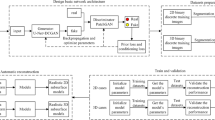Abstract
Gravity inversion is an important approach for obtaining the spatial structure and physical properties of underground geological bodies based on surface information. Owing to the recent advances in deep learning, neural network-based methods have been widely used for gravity inversion. However, convolutional neural networks (CNNs) require a large number of labeled samples, and the generation of such datasets for all considered geological bodies, requiring gravity forward modeling, is expensive in terms of time and storage space. To reduce the dependence on labeled samples, a three-dimensional gravity inversion method based on a cycle-consistent generative adversarial network (Cycle-GAN) is proposed herein. This network comprises two parts: generator subnetworks and discriminator subnetworks. The generator subnetworks generate gravity forward and inversion data, while the discriminator subnetworks mainly ensure the consistency of the distribution between the generated and real data. We compared the results obtained on synthetic and real data. The findings suggest that Cycle-GAN outperforms CNNs in the inversion of underground geological bodies when using a small number of labeled samples. Furthermore, the results obtained using the proposed method on real data from the San Nicolas deposit in central Mexico are consistent with previously reported results.
Similar content being viewed by others
References
Bertete-Aguirre, H., Cherkaev, E., Oristaglio, M., 2002, Non-smooth gravity problem with total variation penalization functional: Geophysical Journal International, 149(2), 499–507.
Di, H., Chen, X., Maniar, H., and Abubakar, A., 2021, Seismic acoustic impedance estimation by learning from sparse wells via deep neural networks: EAGE Annual Conference & Exhibition, 82(1),1–5.
Farquharson, C., 2008, Constructing piecewise-constant models in multidimensional minimum-structure inversions: Geophysics, 73(1), K1–K9.
Fitterman, D. V., Corwin, R. F., 1982, Inversion of self-potential data from the Cerro Prieto geothermal field, Mexico: Geophysics, 47(6), 938–945.
Ghalenoei, E., Dettmer, J., Ali, M. Y., et al., 2021, Gravity and magnetic joint inversion for basement and salt structures with the reversible-jump algorithm: Geophysical Journal International, 227(2), 746–758.
Huang, R., Liu, S., Qi, R., Zhang, Y., 2021, Deep learning 3D sparse inversion of gravity data: Journal of Geophysical Research: Solid Earth, 126(11), 1–18.
Johnson, B. J., Montante-Martinez, A., Canela-Barboza, M., et al., 2000, Geology of the san Nicolas deposit, Zacatecas, Mexico: VMS Deposits of Latin America: Geological Association of Canada, Mineral Deposits Division Special Publication, 2(1), 71–85.
Lv, M., Zhang, Y., Liu, S., 2023, Fast forward approximation and multitask inversion of gravity anomaly based on UNet3+: Geophysical Journal International, 234, 972–984.
Martinez, C., Li, Y., Krahenbuhl, R., et al., 2013, 3D inversion of airborne gravity gradiometry data in mineral exploration: A case study in the Quadrilátero Ferrífero, Brazil: Geophysics, 78(1), B1–B11.
Ohminato, T., Chouet, B. A., Dawson, P., et al., 1998, Waveform inversion of very long period impulsive signals associated with magmatic injection beneath Kilauea Volcano, Hawaii: Journal of Geophysical Research: Solid Earth, 103(10), B23839–B23862.
Phillips, N., Oldenburg, D., Chen, J., et al., 2001, Cost effectiveness of geophysical inversions in mineral exploration: Applications at San Nicolas: The Leading Edge, 20(12), 1351–1360.
Portniaguine, O., Zhdanov, M., 2002, 3-D magnetic inversion with data compression and image focusing: Geophysics, 67(5), 1532–1541.
Rezaie, M., 2019, 3D non-smooth inversion of gravity data by zero order minimum entropy stabilizing functional: Physics of the Earth and Planetary Interiors, 294(1), 106–115.
Rezaie, M., Moradzadeh, A., Kalate, A., et al., 2017, 3D modelling of Trompsburg Complex (in South Africa) using 3D focusing inversion of gravity data: Journal of African Earth Sciences, 130(1), 1–7.
Tikhonov, A. N., Arsenin, V. Y., 1978, Solutions of ill-posed problems: Mathematics of Computation, 32(144), 1320–1322.
Wang, Y., et al., 2019, Seismic impedance inversion based on cycle-consistent generative adversarial network: SEG Annual International Meeting, 89(1), 2498–2502.
Yang, Q., Hu, X., Liu, S., et at., 2021, 3-d gravity inversion based on deep convolution neural networks: IEEE Geoscience and Remote Sensing Letters, 1–5.
Zhu, J. Y., Park, T., et al., 2017, Unpaired image-to-image translation using cycle-consistent adversarial networks: IEEE International Conference on Computer Vision, 22(1), 2223–2232.
Acknowledgments
This study was financially supported by the National Natural Science Foundation of China (Grant nos. 42122025, 42374174 and 42274152).
Author information
Authors and Affiliations
Corresponding author
Ethics declarations
The authors have no conflicts of interest to declare relevant to the content of this article.
Additional information
Qiao Shu-Bo He received his doctoral degree in astrometry and celestial mechanics from the Shanghai Observatory of the Chinese Academy of Sciences in 2011. He is currently a professor at PLA Strategic Support Force Information Engineering University and a member of the Professional Committee of Geodesy and Navigation of the Chinese Society of Surveying and Mapping. His research interests include space and physical geodesy, space datum and coordinate systems, astrometry and geodynamics.
Li Hou-pu He received his Ph.D. degree at Naval University of Engineering in 2010. He is a professor of Electrical Engineering at Naval University of Engineering. His current research mainly includes marine geodesy and geophysics.
Rights and permissions
About this article
Cite this article
Qiao, SB., Li, HP., Qi, R. et al. 3D gravity inversion using cycle-consistent generative adversarial network. Appl. Geophys. (2024). https://doi.org/10.1007/s11770-024-1096-5
Received:
Revised:
Published:
DOI: https://doi.org/10.1007/s11770-024-1096-5



